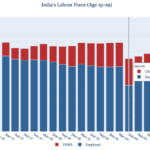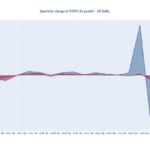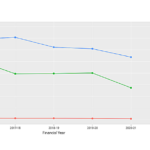CEDA-CMIE Bulletin no. 10: More farmers and fewer wage labourers
Key findings:
- At national level, number of people employed in farming has steadily increased, from 91 million in 2016 to 120 million 2021.
- Number of people employed as small traders or daily wage labourers has declined from 173.3 million in 2016 to 124.5 million in 2021.
- Small traders and wage labourers made up 43 percent of all employed people in 2016. This proportion has declined to 31 percent in 2021.
- Between 2019 and 2021, the number of people in salaried jobs has declined from 87.4 million to 78.3 million. Sharpest decline seen in Rajasthan.
- 9 percent increase in farming employment in 2021 over 2019 across the country. Sharpest increase seen in Jharkhand.
In our recent CEDA-CMIE Bulletins we have looked at changes in employment across the country by gender and by age. In this bulletin we focus on changes in employment by occupation. The analysis is based on time series data from CMIE that has tracked occupation-wise employment for India since Q1 (Jan-Mar) 2016 and for states since Q1 (Jan-Mar) 2019.
Table 1 shows us the average monthly employment by occupation in a calendar year.
We can see that the total number of employed people in 2021 was 397.9 million which was 4.5 percent higher than 2020 but still 1.5 percent lower than 2019. Between 2016 and 2021, the biggest decline has been seen among small traders and wage labourers whose average monthly employed numbers have declined from the high of 173.3 million in 2016 to 124.5 million in 2021. This is a decline of 28.5 percent between 2016 and 2021. The number of people employed in small trade or as wage labourers in 2021 is still lower than the pre-pandemic year 2019. Even the salaried have seen their numbers decline 11 percent between 2016 (88.1 million) to 2021 (78.3 million).
On the other hand, the number of people employed in farming has steadily increased year-on-year between 2016 and 2021. While 91.1 million people were employed in farming in 2016, this number has increased to 120.3 million in 2021, a growth of 32.2 percent.
It needs to be noted that the category “Small Traders & Wage Labourers” also includes farm labourers (different from farmers). CMIE data for 2019, 2020, and 2021 shows average number of farm labourers at 36.1 million, 30.3 million, and 36.3 million respectively. Thus, we don’t see a sharp increase in farm labourers in 2020 (the pandemic year) even though the number of farmers has shown a steady increase.
Table 1
| Category | 2016 | 2017 | 2018 | 2019 | 2020 | 2021 |
|---|---|---|---|---|---|---|
| Total Employed | 406.6 | 407.2 | 402.3 | 404.0 | 380.7 | 397.9 |
| Business | 53.0 | 60.0 | 68.1 | 76.4 | 77.6 | 74.7 |
| Salaried | 88.1 | 86.6 | 88.1 | 87.4 | 74.2 | 78.3 |
| Small Traders & Wage Labourers | 173.3 | 161.0 | 142.8 | 129.5 | 109.4 | 124.5 |
| Farmers | 91.1 | 99.1 | 102.6 | 110.4 | 119.4 | 120.3 |
All figures in millions
Absolute numbers do not reveal the full picture of changes in employment by occupation. Figure 1 shows us the percentage break-up of employment by occupation between 2016 and 2021. We can see that small traders and wage labourers make up the biggest share of all employed people, but their share has declined from 42.6 percent in 2016 to 31.4 percent in 2021. The percentage of farmers has increased from 22.5 percent in 2016 to 30.2 percent in 2021. Similarly, the percentage of those employed in business has increased from 13 percent in 2016 to 18.8 percent in 2021.
Figure 1
Figure 2 shows us the average number of people employed in salaried jobs every month of 2019, 2020, and 2021 across states. For India, average monthly salaried employment was 87.4 million in 2019 which declined to 74.2 million in 2020 before increasing to 78.3 million in 2021. The average monthly employment in 2021 was thus 6 percent higher than 2020 but 10 percent lower than 2019.
Among large Indian states, the sharpest decline in 2020 (over 2019) was seen in Rajasthan at 31 percent while states like Haryana, J&K, Tamil Nadu, Maharashtra, MP, and others saw a decline of 20 percent or more. If we compare 2021 with 2019, we find that Rajasthan saw the biggest decline at 31 percent followed by J&K at 30 percent.
Figure 2
Figure 3 shows us the average number of people employed in farming every month in 2019, 2020, and 2021 across Indian states. As shown in Figure 1, farming has seen employment increase between 2016 and 2021. It employed 110 million people in 2019 which increased to 120 million in 2021, a growth of 9 percent. Among larger Indian states, the biggest increase in farming employment was seen in Jharkhand which saw a 33 percent increase in 2020 over 2019 (1.7 million to 2.2 million) and a 53 percent increase in 2021 over 2019 (1.7 million to 2.5 million). Maharashtra saw an increase of 30 percent in 2020 over 2019 and an increase of 21 percent in 2021 over 2019.
Figure 3
Conclusion
The last two CEDA-CMIE bulletins highlighted two major issues. One, of women exiting the workforce and second, of the sharp increase in India’s youth unemployment. The third bulletin in this series shows us how the sectoral mix of India’s employment is changing.
Nationally, the number of salaried employees, small traders & wage labourers have decreased in numbers over the last few years, while the number of farmers has increased.
The more than 30 percent increase in farm employment between 2016 and 2021 coupled with the decline in salaried employment in the same period underlines the weakness of India’s economy which has not been able to provide employment outside its small sized farms.
These three CEDA-CMIE bulletins paint a grim picture of India’s employment situation and reveal the difficult position for policy makers.
If you wish to republish this article or use an extract or chart, please read CEDA’s republishing guidelines.







